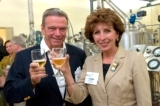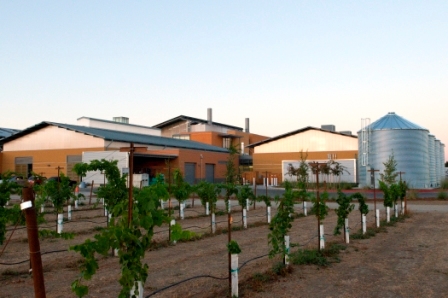Posts Tagged: milk
The debate over dairy products is being milked for all its worth
Since the 1960s, nutrition experts have encouraged Americans to forgo whole milk in favor of skim or low-fat dairy products. Now some scientists are saying the move to low-fat dairy is tied to the country's obesity crisis, according to an article in The Guardian
Robert Lustig, professor of pediatric medicine at UC San Francisco, said he believes drinking whole milk can lead to lower calorie intake overall because it is more filling than low-fat and non-fat alternatives.
A UC Agriculture and Natural Resources (UC ANR) expert shared a different viewpoint. Lorrene Ritchie, director of the UC ANR Nutrition Policy Institute, said low-fat or skim milk products are still preferable to whole milk because liquid calories are not as filling as equivalent calories from solid food. Nationwide, the goal for most people should be to reduce calorie intake.
"Until we decrease calorie intake on a population level, we are unlikely to see much reversal in the obesity epidemic," Ritchie said.
Before the end of 2015, the federal government is expected to release its revised Dietary Guidelines for Americans. According to the Guardian article, the guidelines are expected to tout vegetables, fruits, whole grains, legumes, nuts, seafood and "low- or non-fat dairy." The guidelines inform the USDA's dietary infographic, which at the moment takes the form of a plate half filled with vegetables and fruit, and the other half with a small portion of protein food and whole grains.
The Nutrition Policy Institute has been advocating for the addition of water on the MyPlate icon to reinforce its position that plain tap water is the best choice for quenching thirst.
Is livestock’s contribution to climate change still being overestimated?
In a 1,000 year old village in Germany (Juehnde), methane is not a dirty word. The recovered methane from a manure-fueled bioreactor feeds the burners that heat water for every household in the village. The same hot water provides heating. These households benefit from living adjacent to a livestock economy whose manure was once just a smelly nuisance. The manure is transported by truck to an enclosed bioreactor, thereby reducing odor and feeding a system that powers an entire community. Frank Mitloehner once called this village home. Now a professor and air quality UC Cooperative Extension specialist in the Department of Animal Science at UC Davis, Mitloehner thinks that if this village can do it, so can California.
It is easy to see how Mitloehner was inspired to study ways that California can take advantage of its plentiful supplies of animal methane. In eight bovine bio-bubbles that function as airtight barns, he captures and measures every emission from his resident livestock in order to understand how methane emissions vary with feed and herd management.
At Davis, a commercialized version of a similar methane bio-reactor has been patented and licensed by Ruihong Zhang, professor in the Department of Biological and Agricultural Engineering at UC Davis. It has been constructed at the local landfill and will be used to demonstrate a sustainable village on the UC Davis campus.
Mitloehner recently hosted a seminar for the Western Center for Agricultural Health and Safety at Davis. Since the Food and Agriculture Organization of the United Nations (FAO) committee released their 2006 report entitled, “Livestock’s Long Shadow,” he has challenged two key misleading sentences in their report. The phrase compared the contribution of livestock emissions to that of transportation. By saying the contributions to climate change were similar, the report led many environmental advocates to the conclusion that eating less meat was the equivalent of taking cars off the road, setting up a meat vs. miles tradeoff that exaggerated the methane contributions of livestock everywhere.
Mitloehner’s response was the publication Clearing the Air, Livestock’s Contribution to Climate Change. After his paper was released, BBC, CNN and other media published his science-based estimate that the livestock contribution in the U.S. is 3.4 percent of U.S. emissions. Globally, 18 percent of warming was estimated to be livestock related. This estimate included livestock in the broadest sense - changes in land use, deforestation and desertification in developing countries.
In spite of Mitloehner’s paper, the meat vs. miles perception has persisted among advocates, while press about transportation GHG has dwindled. Toyota took advantage in their advertising by showing how Prius emissions were more favorable than those of a sheep.
Nonetheless, Mitloehner showed that U.S. methane emissions remain flat, while developing countries are increasing animal production to meet the demand for eggs, meat and dairy, especially Asia. But why is the U.S. so low?
Mitloehner shared a few facts that help explain the phenomena:
- The U.S. has fewer dairy cows. Today’s 9 million dairy cows supply 60 percent more milk than the 16 million cows in production in 1950. That means there is increased efficiency per cow for the same methane produced.
- Thirty percent of the methane in dairy production is from manure in ponds. There is the potential for recovery on the approximately 1,500 California farms, where the average herd size is 1,100 head.
- Methane has 20 times the warming potential of carbon dioxide, but when burned to heat water or to generate power, its warming potential is reduced by a factor of 20.
- The more fiber in the feed, the more methane is released by the rumen of the animal. One dairy cow in the U.S. produces an average of 20,000 lbs of milk per cow annually, the same amount of milk as five cows in Mexico, or up to 100 cows in India for the same, or less methane per cow. Reasons: low fiber diet, less parasites and less disease result in large differences in production per cow.
Mitloehner occupies that middle space between the economically driven farmers who survived years of falling milk prices and the sustainable advocates that want dairy to either disappear entirely or retreat into historical practices. When he is not serving on the President’s Council of Advisors on Science and Technology (PCAST) or the National Academies Institute of Medicine, he keeps company with local farmers and students and answers to science.
Dairy addicts like myself, whose ancestors have evolved on milk for over 10,000 years, are likely to continue to frequent the organic dairy cases, hopeful that there are mutual benefits to paying higher prices for local labels in returnable glass bottles as a way to sustain the farms.
In reality, California has been exporting surplus dairy products to growing populations since the 1890s and that won’t change soon. Those markets do more to keep dairies profitable than my weekly milk and yogurt purchase. Lactose for pharmaceuticals and whey proteins for infant formulas are shipped internationally from several of California’s mammoth cheese factories, sometimes worth more the cheese itself.
Mitloehner believes that “sustainable intensification” is the solution to keeping local dairies viable. He believes that science will provide the path to better regulation. The dairy nations that seem determined to get at the truth - New Zealand, France, Ireland and the Netherlands - have formed an international partnership at FAO entitled LEAP to address the issues. Mitloehner's leadership a chair of the partnership will keep methane bioreactors on the agenda.
More information:
Mitloehner tells the story of how he neutralized errors in the FAO report “Livestock’s Long Shadow” (YOUtube).
LEAP site at the FAO. NGOs include World Wildlife Federation and Greenpeace. Mitloehner said that Greenpeace is also a partner although not listed on the site. Workshop materials available for download.
July 2012 opinion post by Robert Goodland at New York Times food blog. This is an example of criticism of Mitloehner’s role as head of the FAO partnership LEAP (Livestock Environmental Assessment and Performance).
Milk prices going up; nitrate report gets more coverage
A story about USDA milk production forecasts for 2012 and 2013 included commentary from Leslie "Bees" Butler, UC Cooperative Extension specialist in the Department of Agricultural and Resource Economics as UC Davis.
Rising feed prices have caused some producers to sell cows rather than bear the expense of feeding them. Another option is to slaughter cows. Dairies have been doing that a lot -- to the chagrin of glut-wary beef producers -- since 2009 when the all milk price dropped to as low as $11.30 per hundred pounds, the story said.
A strong dollar at the time made foreign goods cheaper and domestically produced goods more expensive, Butler told reporter Courtenay Edelhart. That dried up the export market for American milk and led to oversupply at home that still hasn't been entirely corrected, he said.
Water agency urges farmers to test ground water for contamination
KTVU.com
Landmark new rules adopted by the Central Coast Regional Water Quality Control Board will require farmers to test ground water for nitrate contamination and report their fertilizer usage, according to the KTVU report.
The story mentioned that a recent UC Davis study showed 254,000 people in the Tulare Lake Basin and Salinas Valley were at risk of drinking water contaminated with nitrates, much of which came from fertilizer.
World's first LEED Platinum winery, brewery and food-processing labs
A new winery, brewery and food-processing complex at the University of California, Davis, is the most environmentally sophisticated complex of its kind in the world, one that promises to unravel scientific enigmas and solve practical problems related to foods, beverages and health.
The $20 million, 34,000-square-foot teaching-and-research complex is the first winery, brewery or food-processing facility expected to earn LEED Platinum certification, the highest environmental rating awarded by the U.S. Green Building Council. It is intended to become self-sustainable in energy and water use.
Neal Van Alfen, dean of the College of Agricultural and Environmental Sciences at UC Davis, said, "It will serve as a model for industries throughout the nation that are also committed both to environmental excellence and production efficiency."
The complex houses a brewery, general foods-processing plant, milk-processing laboratory, and a teaching-and-research winery which will serve as a test bed for production processes that conserve water, energy, and other resources. The complex is adjacent to a 12-acre teaching-and-research vineyard.
Its environmentally friendly features include on-site solar power generation, a large-capacity system for capturing rainwater and conserving processing water, and many other features. The facility is expected to be carbon zero in carbon emissions.
Read more about the facility and take an online tour at the facility’s website.
California Report covers dairies' desperate times
A long excerpt from a recent UC online seminar for dairy operators on suicide prevention was used in a lengthy segment about the plight of California dairies on the California Report this morning. The story, by Fresno NPR reporter Sasha Khokha, noted that the Los Angeles Times reported in May that two dairymen have committed suicide as dairy industry profits crash. Currently, dairy operators earn about half what it costs them to produce milk.
Much of Khokha's story was pulled from an emotional interview with Point Reyes dairy operator Joey Mendoza, whose immigrant grandfather started the dairy nearly 100 years ago.
"It's sad, but it's something you have to do," Mendoza told the reporter, his voice cracking with despair. "There are guilt pains because of the heritage. Everybody worked so hard to build this thing and you're the one that has to terminate it and let it go. It's humiliating and you're not very proud of yourself to do something like this."
Mendoza has decided to participate in a herd retirement program that requires dairies to sell the entire herd for slaughter and stop milking cows for at least a year. The program is expected to take about 100,000 cows out of the national milking herd of 9 million, Khokha reported. Mendoza said he may try to open the dairy again one day as an organic operation.







